Thursday 14 March 2019 marked not just the final flight of the RAF’s Tornado GR.4, but also that of another hugely successful military aircraft – the Northrop Grumman EA-6B Prowler. Gareth Stringer looks back on its development and lengthy operational career with the help of some stunning imagery.
On Friday 8 March, VMAQ-2 (US Marine Tactical Electronic Warfare Squadron 2), part of Marine Aircraft Group 14, 2nd Marine Aircraft Wing and stationed at Marine Corps Air Station Cherry Point, disbanded. After more than 40 years of service, the EA-6B’s operational career was over.
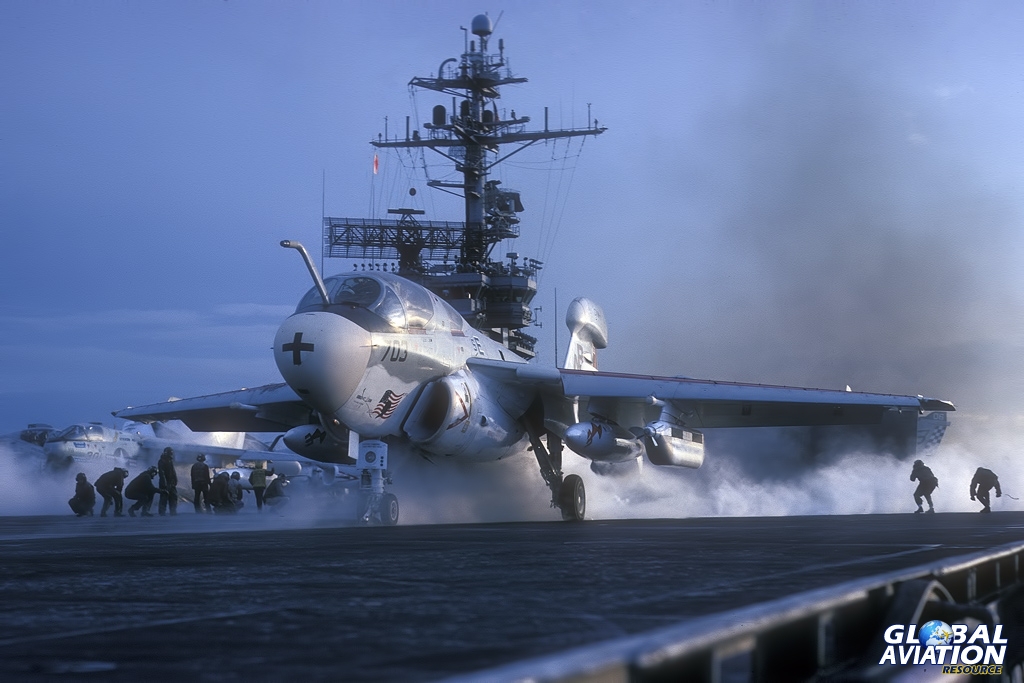
EA-6B – 158804 – VAQ-133 – USS Kennedy – 12/75 © Lindsay Peacock – Global Aviation Resource
Instantly recognisable, the Prowler is a twin-engine, four-seat, specialist electronic-warfare aircraft and was an advanced development of the two-seat EA-6A, which was itself a variant of the A-6 Intruder all-weather attack aircraft. Conceived specifically for the US Marine Corps to replace the Douglas EF-10B Skyknight, only 27 examples of the EA-6A entered service.
The F-10 Skyknight, previously designated F3D Skyknight, first flew in 1948 and entered service in 1951 as night fighter and, due to its somewhat rotund appearance, earned itself the nickname ‘Willie the Whale’. But, appearances aside, the Skyknight not only downed a number of MiG-15 aircraft in the Korean War but played an important part in the development of the radar guided Sparrow missile as well as an electronic warfare (EW) platform – the precursor to the Prowler.
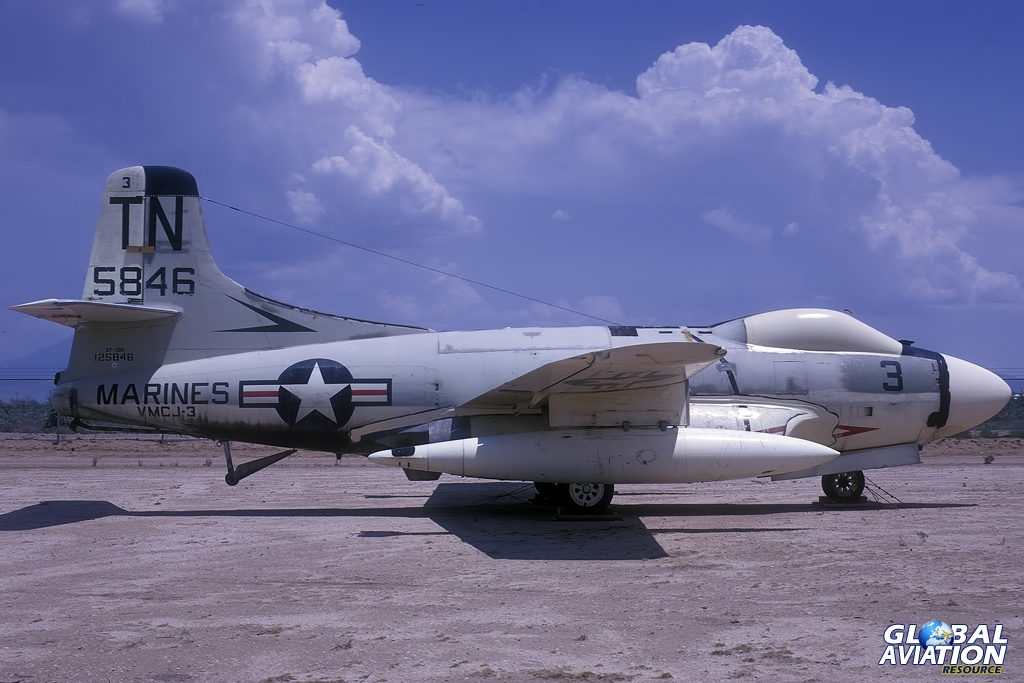
EF-10B – 125846 – VMCJ-3 – Davis Monthan AFB – 08/70 © Lindsay Peacock – Global Aviation Resource
The EF-10B variant had proved itself to be a valuable asset in Vietnam and was utilised to jam the SA-2 surface-to-air missile’s tracking and guidance systems. Perhaps most notably, on 29 April 1965 Marine Corps squadron VMCJ-1 made history when its EF-10Bs conducted the first ever USMC airborne radar jamming mission in support of an Air Force strike package.
The ageing EF-10B was in line for replacement though, with the Marine Corp’s first production EA-6A entering service with VMCJ-2 in December 1965. The aircraft was deployed to Vietnam in October 1966 where it served with VMCJ-1 throughout the conflict. It is interesting to note that, due to demand for EW support, the EF-10B would eventually remain in theatre until 1969!
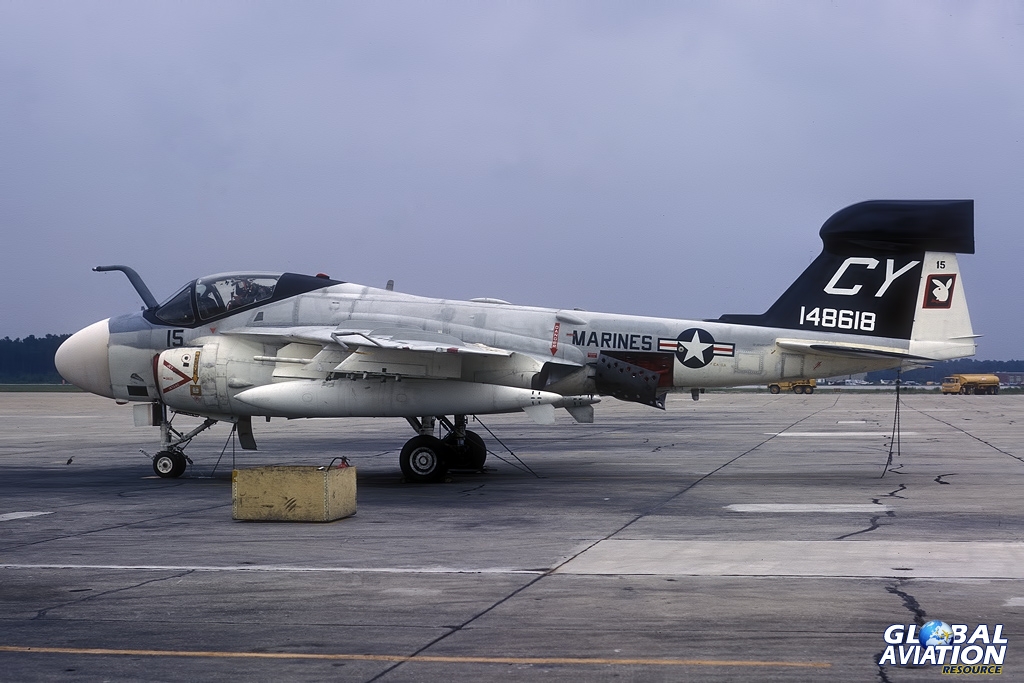
EA-6A – 148618 – VMCJ-2 – Cherry Point – 09/72 © Lindsay Peacock – Global Aviation Resource
The EA-6A was a modified A-6 Intruder and was equipped with an AN/ALQ-86 ECM (electronic counter measures) suite and the AN/APQ-129 fire control radar, though the EA-6A never used offensive weapons in Vietnam. Most of the additional electronics were fitted within a fairing that was mounted on the vertical fin, sometimes called the ‘football’. The aircraft carried an ALQ-31 pod that contained a pair of radar jammers but this was soon replaced by the ALQ-76. This pod featured its own RAM (Ram Air Turbine) which allowed it to provide power to no less than four jammers and a typical load-out would see an EA-6A carrying three of the ALQ-76 pods, two chaff dispensers for self defence and pair of fuel tanks. This made it the most effective EW platform of its time and that load-out would form the basis for the EA-6B that followed later.
In Vietnam the EA-6A was dedicated to performing the ECM escort role; namely escorting USMC A-6A Intruders on night time missions as they attacked heavily defended targets deep in North Vietnam. The ‘Electric Intruder’ (not an official name) was also instrumental in helping to reduce losses of American attack and reconnaissance aircraft to SA-2 surface-to-air missiles and radar controlled AAA (anti aircraft artillery) and provided major support for the Linebacker I and Linebacker II B-52 raids that eventually ended the air war over North Vietnam.

EA-6A – 151596 – VMCJ-3 – North Island- 10/73 © Lindsay Peacock – Global Aviation Resource
The EA-6A began to be phased out of operational service in the mid-1970s but the aircraft remained in use, both with USN and USMC Reserve units and also the Navy’s specialised VAQ (electronic attack) units, primarily for training purposes. The EA-6A was retired in 1993 and the last units to operate the type were VAQ-33, an electronic aggressor squadron, and Reserve units VAQ-209, VAQ-309 and VMAQ-4.
Development of the significantly redesigned and greatly advanced EA-6B Prowler actually began back in 1966 with the ‘new’ aircraft slated to replace both the EA-6A and the US Navy’s EKA-3B Skywarrior, which didn’t itself deploy until 1967. This, like the EF-10B mentioned above, was an EW variant of an existing platform, namely the A-3B Skywarrior or ‘the Whale’; the A-3 being the heaviest operational aircraft to normally operate from an aircraft carrier.
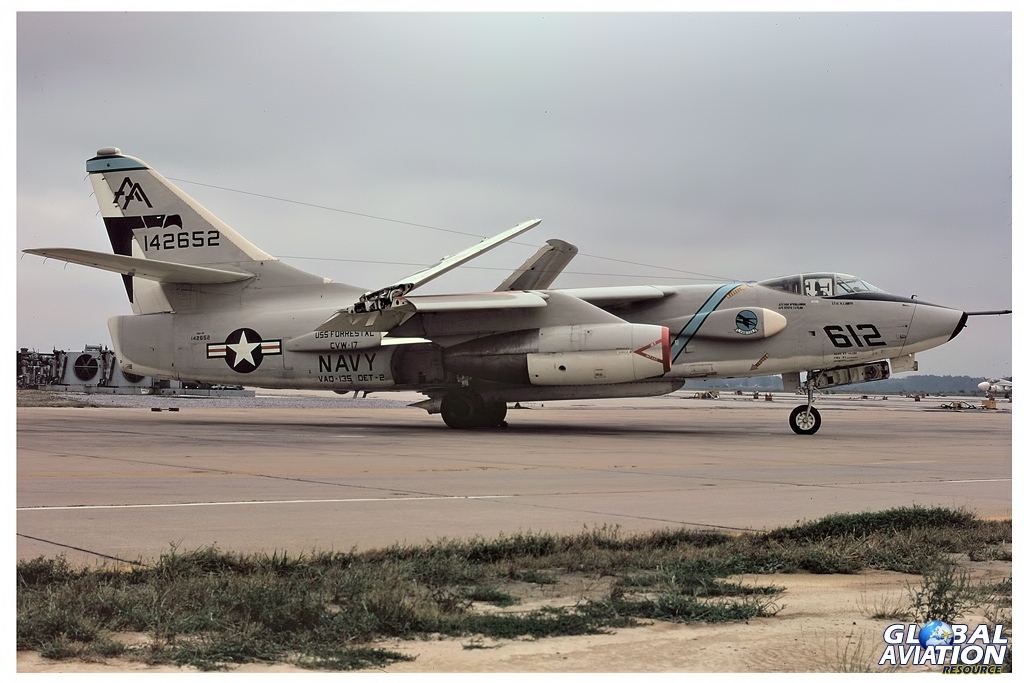
EKA-3B – 142652 -VAQ-135 – Det 2 – Oceana – 09/72 © Lindsay Peacock – Global Aviation Resource
The EA-6B’s most obvious external development from the EA-6A was that the forward fuselage was lengthened to create a new area for a much larger cockpit. The result was a four-seat, long-range, all-weather, twin-engine aircraft, designed purely to locate, analyse and jam hostile radar and other electronic systems; clearing the way for allied fighter and attack aircraft by effectively suppressing the enemy’s air defences.
A forward equipment bay and large, pod-shaped fairing on the aircraft’s vertical fin housed additional avionics equipment while design peculiarities of note were a canted refuelling probe (at 12°) and a gold-shaded canopy to protect the crew (one pilot and three Electronic Countermeasures Officers or ECMO) against radio emissions from the aircraft’s powerful electronic warfare equipment.
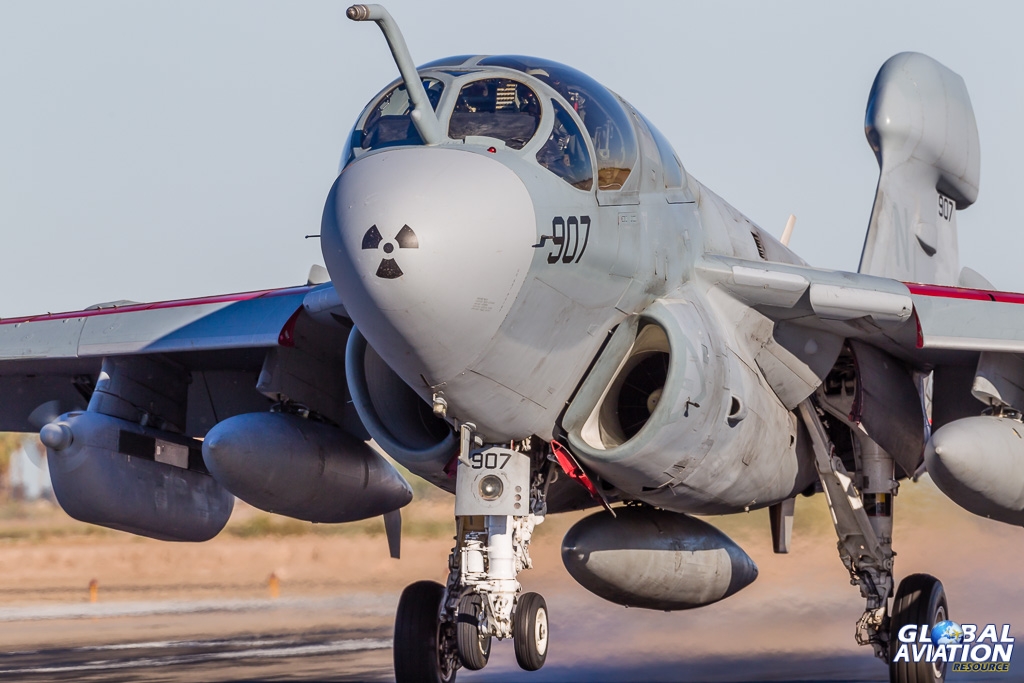
© Rob Edgcumbe – Global Aviation Resource
Measuring sixty feet (17.7 m) in length with a wingspan of 53 ft (15.9 m), the EA-6B was powered by two non-afterburning Pratt & Whitney J52 engines with a top speed of approx 600 mph and a published range of 1,140 miles, or almost 2,500 miles if fitted with drop tanks. A grand total of 170 EA-6B aircraft were manufactured from 1966 through 1991 and the Prowler flew more than 260,000 hours on operations with the US Marine Corps alone.
The US Navy’s Fleet Replacement Squadron VAQ-129 brought the EA-6B into service in September 1970 and the first operational squadron was Tactical Electronic Warfare Squadron 132 (VAQ-132), in July 1971. VAQ-132 deployed to Vietnam on the USS America some 11 months later and was soon followed by VAQ-131 on USS Enterprise and VAQ-134 on USS Constellation.

Airman Francisco Escobedo, assigned to the Gauntlets of Electronic Attack Squadron One Thirty Six (VAQ-136), prepares a High Speed Anti-Radiation Missile (HARM) on an EA-6B Prowler on the flight deck aboard the aircraft carrier USS Kitty Hawk (CV 63) – U.S. Navy photo by Photographers Mate 3rd Class Todd Frantom
The Prowler would go on to serve with distinction, for both the US Navy and USMC, frequently in support of USAF combat operations, first in Vietnam and then in Grenada, Libya (Operation El Dorado Canyon in 1986) and Operation Desert Storm (Gulf War 1 – 1990 / 1991).
During the latter, 39 EA-6B Prowlers were involved, with 27 operating from six aircraft carriers and 12 from USMC land bases. Flying some 4,600 flight hours, Prowlers fired over 150 HARM missiles across 1,132 US Navy sorties and 516 USMC sorties, with no losses.

EA-6B – 158800 – VAQ-138 – USS Kennedy – 12/80 © Lindsay Peacock – Global Aviation Resource
Between the retirement of the EF-111 in 1998 and the first EA-18G Growler unit being declared operational in 2009, the Prowler was actually the only dedicated EW platform in service with the US armed forces. In 2001 a total of 124 Prowlers remained and these were divided between twelve US Navy, four USMC and four joint US Navy / US Air Force ‘expeditionary’ squadrons. It had been a Joint Chiefs of Staff (JCS) staff study that had recommended the retirement of the EF-111 Raven in order to cut down on the types of aircraft in service that were dedicated to the same mission. This in turn led to a memorandum from the Office of the Secretary of Defense and the four land based expeditionary Prowler squadrons were formed to meet the EW needs of the US Air Force.
For several years the Prowler was used to counter improvised explosive devices in Afghanistan and Iraq and it has also been reported, although never confirmed by the Department of Defense, that an EA-6B was used to suppress radar while assisting the helicopters that raided Osama Bin Laden’s Pakistan compound in Operation Neptune Spear.
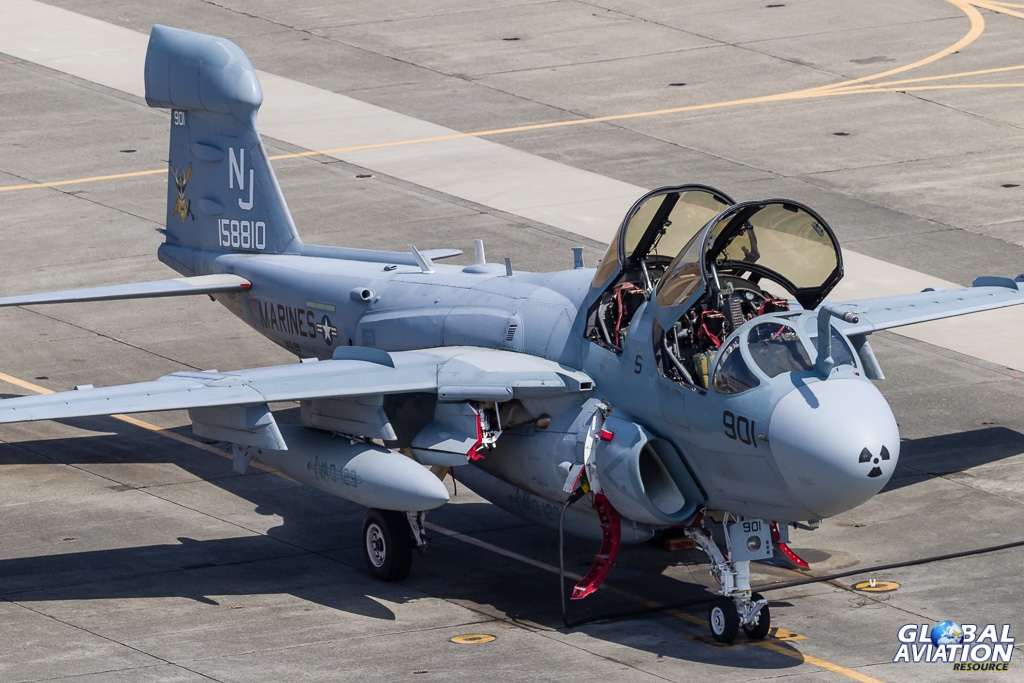
© Rob Edgcumbe – Global Aviation Resource
Prowler missions against the so-called Islamic State commenced over Iraq in June 2014 with VMAQ-3 and when Operation Inherent Resolve (the US’s operational name for the military intervention against the Islamic State of Iraq and Syria) officially began in August that year, VMAQ-4 took over. The Prowlers were the first Marine Corps aircraft to operate in Syria and by January 2015 the aircraft of VMAQ-4 had flown 800 hours (110 sorties) in support of operations in both countries. In April 2016 Prowlers were deployed to Incirlik Air Base in Turkey for operations over Syria and these continued until the EA-6Bs of VMAQ-2 finally completed the aircraft’s last operational deployment in November 2018.
By this time the aircraft had already completed its last US Navy tour, late in 2014, and the Prowler had been fully withdrawn from Naval service in June 2015, while the Marines had begun drawing down its squadrons ahead of the aircraft’s planned retirement in 2019. That draw-down commenced with the deactivation of the Marine Tactical Electronic Warfare Training Squadron (VMAQT-1) in 2016 and this was followed by VMAQ-4 in June 2017 and VMAQ-3 in May 2018.
VMAQ-2 – 04/03/19 (U.S. Marine Corps photo by Lance Cpl. Liam Higgins / Released)
Although time and technology caught up with the Prowler eventually, the EA-6B was continually upgraded during its long career. The first major upgrade was named ‘expanded capability’ (EXCAP) and this was implemented in 1973. Following EXCAP was ‘improved capability’ (ICAP) in 1976 and then ICAP II in 1980, with the latter providing the EA-6B with improved displays for its crew, updated computers, navigational systems and jammers along with the ability to fire the AGM-88 HARM missile.
Deliveries of ICAP II aircraft commenced in 1984 and all existing ICAP aircraft were upgraded with the 170th, and final, Prowler being delivered on July 29 1991. In terms of avionics the definitive, ICAP III, EA-6B was equipped with a host of complex and seemingly ever-changing suite of electronics, such as the AN/ALQ-218 Tactical Jamming System Receiver and AN/USQ-113 Communications Jamming System. The former is an airborne integrated jamming system, both designed and manufactured by Northrop Grumman, and can also be found in the EA-18G Growler and P-8 Poseidon aircraft.
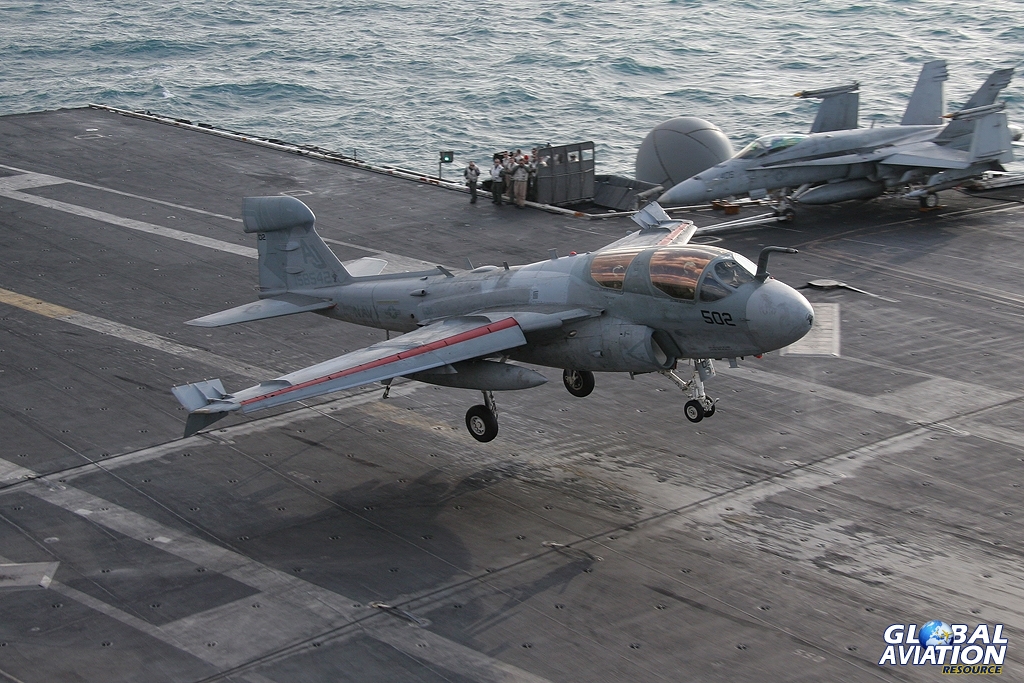
EA-6B – Prowler – VAQ-141 – CVN-71 – Persian Gulf – 01/06 © John Higgins – Global Aviation Resource
The last two official Prowler flights were on 12 March 2019 to the Frontiers of Flight Museum in Dallas and 14 March 2019 (the same day as the Tornado GR.4) to the National Air and Space Museum in Virginia.
The remaining Prowlers are to be stored in the boneyard at Davis-Monthan Air Force Base and thus marks the end of a long, successful and distinguished career – the Prowler prowls no more.
Prowler sunset – U.S. Marine Corps photo by Cpl. N.W. Huertas / Released
US Navy Prowler Squadrons (note – unless stated, all these units were based at NAS Whidbey Island, about 30 miles north of Seattle, Washington)
VAQ-128 Fightin’ Phoenix
VAQ-129 Vikings
VAQ-130 Zappers
VAQ-131 Lancers
VAQ-132 Scorpions
VAQ-133 Wizards
VAQ-134 Garudas
VAQ-135 Black Ravens
VAQ-136 Gauntlets (Based at NAF Atsugi Japan)
VAQ-137 Rooks
VAQ-137 Rooks
VAQ-138 Yellowjackets
VAQ-139 Cougars
VAQ-140 Patriots
VAQ-141 Shadowhawks
VAQ-142 Grim Watchdogs
VAQ-35 Gray Wolves (This relatively short-lived unit was formed mainly with staff from a disbanded unit, namely VAQ-142. They elected to adopt a modified version of the unit’s original badge design while taking on a new nickname, the Gray Wolves. The unit was part of the Fleet Electronic Warfare Support Group)
VAQ-142 Greywolves (This second iteration of VAQ-142 stood up on 1 April 1997. The new unit adopted a slightly modified version of the name taken of VAQ-35, which by then had disbanded, along with the dog insignia from the original VAQ-142 patch.)
VAQ-209 Star Warriors (Based at NAF Washington)
VAQ-309 AxemenUS Marine Corps Prowler Squadrons (All part of Marine Air Group 14 and based at MCAS Cherry Point, North Carolina)
VMAQ-1 / VMAQT-1 Screamin’ Banshees
VMAQ-2 Playboys / Panthers / Death Jesters
VMAQ-3 Moon Dogs
VMAQ-4 Seahawks
On 7 December 2013 EA-6B 158811 launched from NAS Whidbey Island on its final flight to its new home at the Pacific Coast Air Museum in Santa Rosa, California.
On board were three GoPro cameras to capture the flight and the excellent video below was the result.
Gareth Stringer would like to thank Rick Morgan from the Prowler Association for his assistance with this feature.
Coming soon to GAR……….’Prowler from the cockpit’
Prowler in pictures

